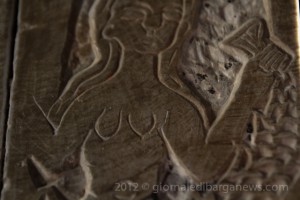 There is now a renewed interest in the phenomenon which happens in Barga twice a year ( weather conditions permitting) of the double sunset – as the setting sun reappears momentarily through Monte Forato. A book on the subject was presented here in Barga just a couple of months ago ( article here) which once again put forward the theory that the position of the Duomo in Barga Vecchia was in some way connected to the double sunset – a theory which was also put forward in 2010 by professor Stefano Borsi in his book – “Le origini di Barga e il culto di San Cristoforo” (Libria di Melfi, 2009)
There is now a renewed interest in the phenomenon which happens in Barga twice a year ( weather conditions permitting) of the double sunset – as the setting sun reappears momentarily through Monte Forato. A book on the subject was presented here in Barga just a couple of months ago ( article here) which once again put forward the theory that the position of the Duomo in Barga Vecchia was in some way connected to the double sunset – a theory which was also put forward in 2010 by professor Stefano Borsi in his book – “Le origini di Barga e il culto di San Cristoforo” (Libria di Melfi, 2009)
Borsi believes that Barga’s origins and religious practices are ancient indeed, predating the arrival of both Christianity and the Greco-Roman deities it replaced.
The vast, austerely rectalinear nave of the Duomo, surveyed by the towering oak statue at its eastern end, officially dates back “only” a thousand years or so. Yet its form and some of its foundation stones appear to be far older than that, and to walk into the Duomo is as close as a modern traveler can get to the actual sensation of entering a temple dedicated to the giant forest and river gods of Italy’s lost Celto-Ligurian civilization, circa 800 BC.
In a fascinating passage of “Le origini, Borsi explores the likelihood that the Duomo’s earliest predecessor was a sanctuary devoted to solar worship. How else, he notes, to explain the careful orientation of the site to achieve a “distant dialogue with Monte Forato” – the face of the celebrated Uomo Morto (“dead man”) crowning the ridgeline of the Apuan Alps across the Serchio River. The purpose, Borsi maintains, was to allow the sanctuary’s priests to make exact observations of the sun’s annual passage, divided in half by the eerie double sunsets over the Uomo Morto that still draw townsfolk to the Duomo terrace twice each year.
This year the cloudy weather conditions during the crucial two days when the event takes place during November denied the possibility of a decent sunset and so the few observers up at the Duomo will have to wait until January for the next possible event but all is not lost for another less spectacular but by no means less mysterious happening in the Duomo.
Twice a year just before the sun sets it shines right through the main door of the Doumo and lights up an area on the left hand side which is for most of the year is kept in shadow and unlit.
A small bas relief carving near to the top of the dividing wall now becomes very visible. Once upon a time it would have been even more noticeable as the outline would have been surrounded by black inserts but at some time in the past, the dark material has been chipped away and cleared leaving the carving more or less invisible for most of the year.
And what is startling image it is – a bare breasted twin tailed mermaid or Melusine.
This morning a visitor to Barga was in search of that image .
Selma Sevenhuijsen a researcher from Amsterdam, Holland arrived in the city to specifically see for herself the image in the Duomo.
She has already written one book on the subject and another is just about to be published (her blog is here)
This creature is associated with numerous stories and legends, and is imbued with symbolic meaning in alchemy. The most common iteration of the siren is as Melusine, a creature from medieval legend. Melusine (sometimes, Melusina) was, according to legend, beautiful woman with a disturbing tendency to transform into a serpent from the waist down while bathing; it is the discovery of this nature that triggers calamity.
As the story is most often told, the cursed maiden is discovered in the forest by Raymond, the Duke of Aquitaine, who begs her to marry him. She agrees, on condition that he never disturb her on a Saturday, when she bathes. Raymond eventually grows suspicious of his young wife, and spies on her- and his shocked reaction to her true appearance reveals his betrayal to Melusine, who transforms herself into a dragon and departs in a shrieking fury. This story can be viewed as a metaphor for sexuality, and the contradictory duality of the female nature as viewed through medieval eyes.
The same dual-nature symbolism is also at work in alchemy, which employs the siren as a more benevolent emblem of enlightenment- the siren of the philosophers. Alchemically, the siren’s two tails represent unity -of earth and water, body and soul- and the vision of Universal Mercury, the all-pervading anima mundi that calls out and makes the philosopher yearn to her.
The Woman’s Dictionary of Symbols and Sacred Objects points out that a double-tailed siren, a baubo siren is a cross between a mermaid and a sheila-na-gig and according to them, the suggestive pose refers to female sexual mysteries and the lure of temptation for any simple-minded fellow. The sheila-na-gig is rooted in paganism and the worship of evil spirits. – source
So where does Starbucks “lewd logo” come into this story of a pagan fertility image in a Christian Duomo in Italy ?
Starbucks Corporation is a global coffee company and coffeehouse chain based in Seattle, Washington. It is the largest coffeehouse company in the world, with 20,366 stores in 61 countries, including 13,123 in the United States, 1,299 in Canada, 977 in Japan, 793 in the United Kingdom, 732 in China, 473 in South Korea, 363 in Mexico, 282 in Taiwan, 204 in the Philippines, and 164 in Thailand.
Starbucks sells hot and cold drinks, coffee beans, salads, hot and cold sandwiches, sweet pastries, snacks, and items such as mugs and tumblers. Through the Starbucks Entertainment division and Hear Music brand, the company also markets books, music, and film. Many of the company’s products are seasonal or specific to the locality of the store. Starbucks-brand ice cream and coffee are also offered at grocery stores.
From Starbucks’ founding in 1971 in Seattle as a local coffee bean roaster and retailer, the company has expanded rapidly. In the 1990s, Starbucks was opening a new store every workday, a pace that continued into the 2000s.
The Logo
 In 2006, Valerie O’Neil, a Starbucks spokeswoman, said that the logo is an image of a “twin-tailed mermaid, or siren as she’s known in Greek mythology”.The logo has been significantly streamlined over the years. In the first version, which was based on a 16th-century “Norse” woodcut, the Starbucks siren was topless and had a fully visible double fish tail. The image also had a rough visual texture and has been likened to a melusine. In the second version, which was used from 1987–92, her breasts were covered by her flowing hair, but her navel was still visible. The fish tail was cropped slightly, and the primary colour was changed from brown to green, a nod to Bowker’s Alma Mater, the University of San Francisco. In the third version, used between 1992 and 2011, her navel and breasts are not visible at all, and only vestiges remain of the fish tails. The original “woodcut” logo has been moved to the Starbucks’ Headquarters in Seattle.
In 2006, Valerie O’Neil, a Starbucks spokeswoman, said that the logo is an image of a “twin-tailed mermaid, or siren as she’s known in Greek mythology”.The logo has been significantly streamlined over the years. In the first version, which was based on a 16th-century “Norse” woodcut, the Starbucks siren was topless and had a fully visible double fish tail. The image also had a rough visual texture and has been likened to a melusine. In the second version, which was used from 1987–92, her breasts were covered by her flowing hair, but her navel was still visible. The fish tail was cropped slightly, and the primary colour was changed from brown to green, a nod to Bowker’s Alma Mater, the University of San Francisco. In the third version, used between 1992 and 2011, her navel and breasts are not visible at all, and only vestiges remain of the fish tails. The original “woodcut” logo has been moved to the Starbucks’ Headquarters in Seattle.
At the beginning of September 2006 and then again in early 2008, Starbucks temporarily reintroduced its original brown logo on paper hot-drink cups. Starbucks has stated that this was done to show the company’s heritage from the Pacific Northwest and to celebrate 35 years of business. The vintage logo sparked some controversy due in part to the siren’s bare breasts,[90] but the temporary switch garnered little attention from the media. Starbucks had drawn similar criticism when they reintroduced the vintage logo in 2006. The logo was altered when Starbucks entered the Saudi Arabian market in 2000 to remove the siren, leaving only her crown as reported in a Pulitzer Prize-winning column by Colbert I. King in The Washington Post in 2002. The company announced three months later that it would be using the international logo in Saudi Arabia.
In January 2011, Starbucks announced that they would make small changes to the company’s logo, removing the Starbucks wordmark around the siren, enlarging the siren image, and making it green. – source
Let’s go all the way back to 1971, to when Starbucks was first coming to be. In a search for a way to capture the seafaring history of coffee and Seattle’s strong seaport roots, there was a lot of poring over old marine books going on. Suddenly, there she was: a 16th century Norse woodcut of a twin-tailed mermaid, or Siren. There was something about her – a seductive mystery mixed with a nautical theme that was exactly what the founders were looking for. A logo was designed around her, and our long relationship with the Siren began. – starbucks.com
Lewd Starbucks Siren Logo ?
Starbucks changed their corporate logo not once but twice because some consumers found the split tail of their topless siren too lurid and suggestive – a nation wide Christian media watchdog organization. The Resistance, with has over 3000 members nationwide boycotting Starbucks across the USA saying their new logo was inappropriate.
The Starbucks logo has a naked woman on it with her legs spread like a prostitute, explains Mark Dice, founder of the group. Need I say more? It’s extremely poor taste, and the company might as well call themselves, Slutbucks. – source
First, a simplified logo was introduced, hiding the siren’s breasts under waves of hair, but it still showed the belly button and the two tails. Then second, this image was cropped and enlarged so the split in the siren’s tail would no longer show.
Now, the only indication that this female icon is a sea creature is in the wavy lines, which originally were part of the representation of the two tails.
httpv://www.youtube.com/watch?v=_APClZ0NrYE











